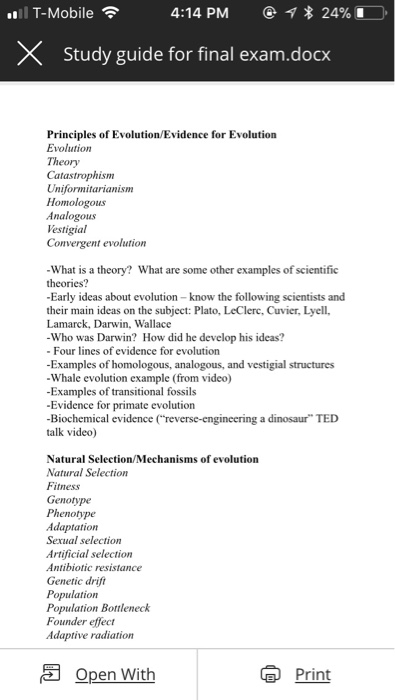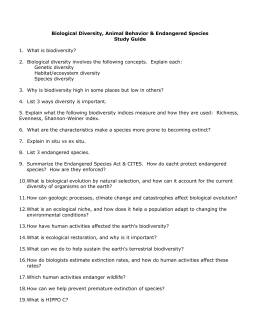Study guide for final exam, Evolution BISC 495-010, Evolution, Spring 2009 Study guide for the final exam The first exam will be Thursday, May 28, from 10:30 a.m to 12:30 p.m. In 206 Brown Lab (the usual lecture room). Those students who will be absent that day can take the exam on Friday, May 22, from 8-10 a.m. You may not use your notes or textbook during the exam. You will not need a calculator. The exam will be worth 35 percent of your grade and will consist of 16 questions worth two points each, and one question worth three points. The exam is cumulative, so you are responsible for all of the material covered in, and the, plus everything covered in all of the lectures.
Be sure you understand what the correct answer was for each question on the first exam and second exams. There are only four lectures' worth of new material between the second exam and the final. You should be familiar with the biological species concept, and how to do experiments to determine whether you have one species or two; allopatric and sympatric speciation, and the puzzles surrounding them; the different forms of creationism and the main points on which they conflict with the scientific evidence; and some of the practical applications of evolutionary biology. This page was last revised May 14, 2009.
Its URL ishttp://udel.edu/mcdonald/495studyguide3.html.

Evolution Test Review Guide Answers
In general, evolution (or organismic evolution) is about changes in populations, species, or groups of species. More specifically, evolution occurs because populations vary by the frequency of heritable traits that appear from one generation to the next.
These traits are represented by alleles for genes that modify morphology (form or structure), physiology, or behavior. Thus, evolution is changes in allele frequencies over time. Evidence for evolution is provided by the following five scientific disciplines:. Paleontology provides fossils that reveal the prehistoric existence of extinct species.

As a result, changes in species and the formation of new species can be studied. Fossil deposits are often found among sediment layers, where the deepest fossils represent the oldest specimens. For example, fossil oysters removed from successive layers of sediment show gradual changes in the size of the oyster shell alternating with rapid changes in shell size. Large, rapid changes produced new species.
Biogeography uses geography to describe the distribution of species. This information has revealed that unrelated species in different regions of the world look alike when found in similar environments. This provides strong evidence for the role of natural selection in evolution. Rabbits did not exist in Australia until introduced by humans. A native Australian wallaby resembles a rabbit both in structure and habit. As similar as these two animals appear, they are not that closely related. The rabbit is a placental mammal, while the wallaby is a marsupial mammal.
Evolution Final Exam Study Guide

The fetus of a placental mammal develops in the female uterus, obtaining nourishment from the mother through the placenta. The fetus of a marsupial leaves the mother's uterus at an early stage of development and completes the remaining development while attached to a teat in the abdominal pouch. The great similarity of the rabbit and the wallaby is the result of natural selection.
Embryology reveals similar stages in development (ontogeny) among related species. The similarities help establish evolutionary relationships (phylogeny).
Gill slits and tails are found in fish, chicken, pig, and human embryos. Comparative anatomy describes two kinds of structures that contribute to the identification of evolutionary relationships among species.
Homologous structures are body parts that resemble one another in different species because they have evolved from a common ancestor. Because anatomy may be modified for survival in specific environments, homologous structures may look different, but will resemble one another in pattern (how they are put together). The forelimbs of cats, bats, whales, and humans are homologous because they have all evolved from a common ancestral mammal.
Analogous structures are body parts that resemble one another in different species, not because they have evolved from a common ancestor, but because they evolved independently as adaptations to their environments. The fins and body shapes of sharks, penguins, and porpoises are analogous because they are adaptations to swimming. Molecular biology examines the nucleotide and amino acid sequences of DNA and proteins from different species. Closely related species share higher percentages of sequences than species distantly related. In addition, all living things share the same genetic code. This data strongly favors evolution of different species through modification of ancestral genetic information. More than 98% of the nucleotide sequences in humans and chimpanzees are identical.